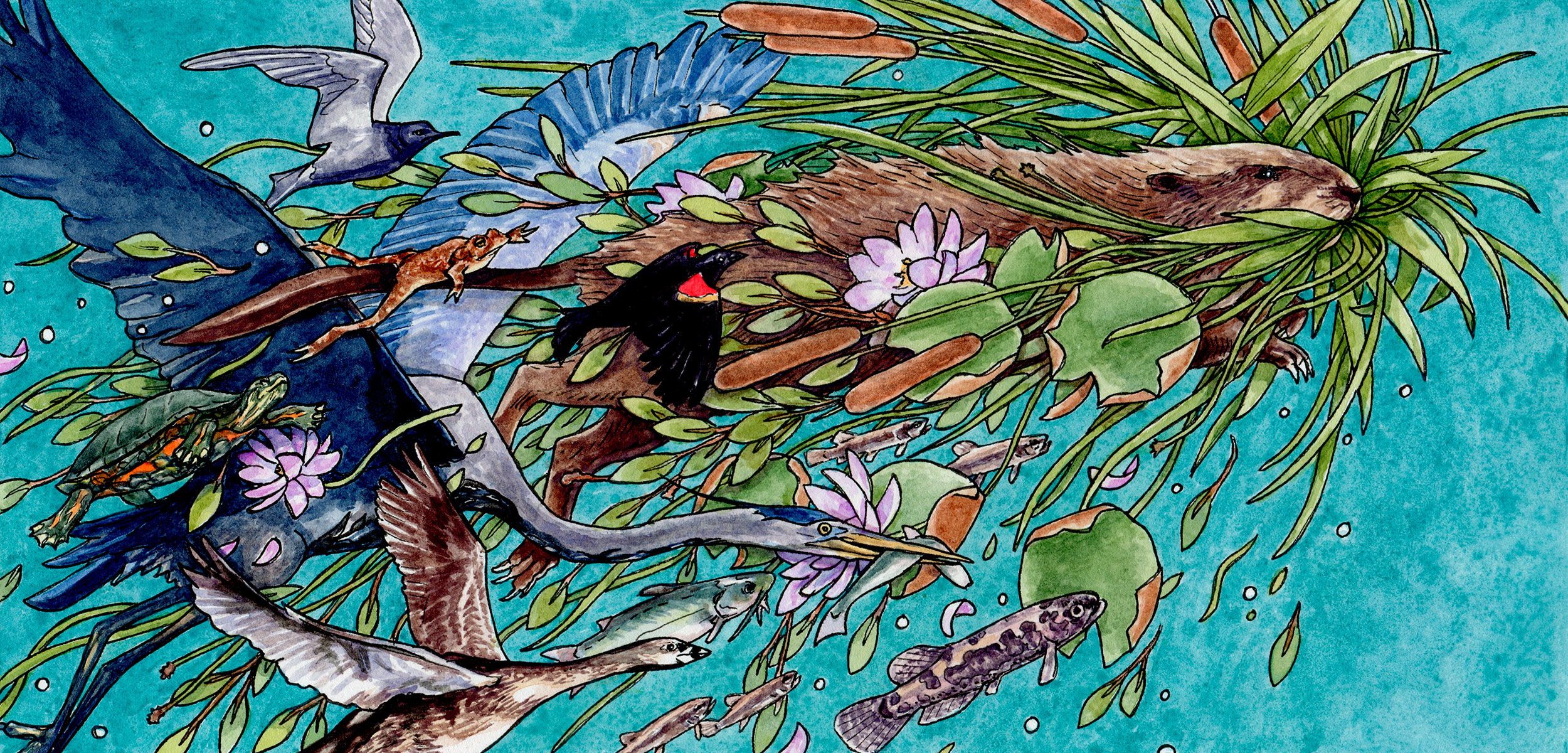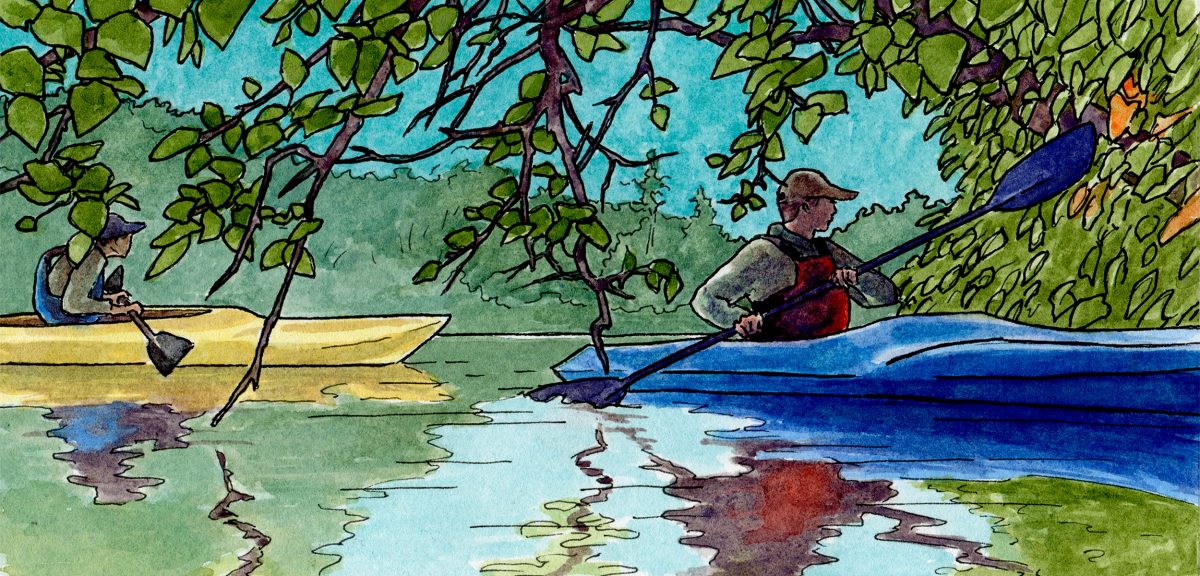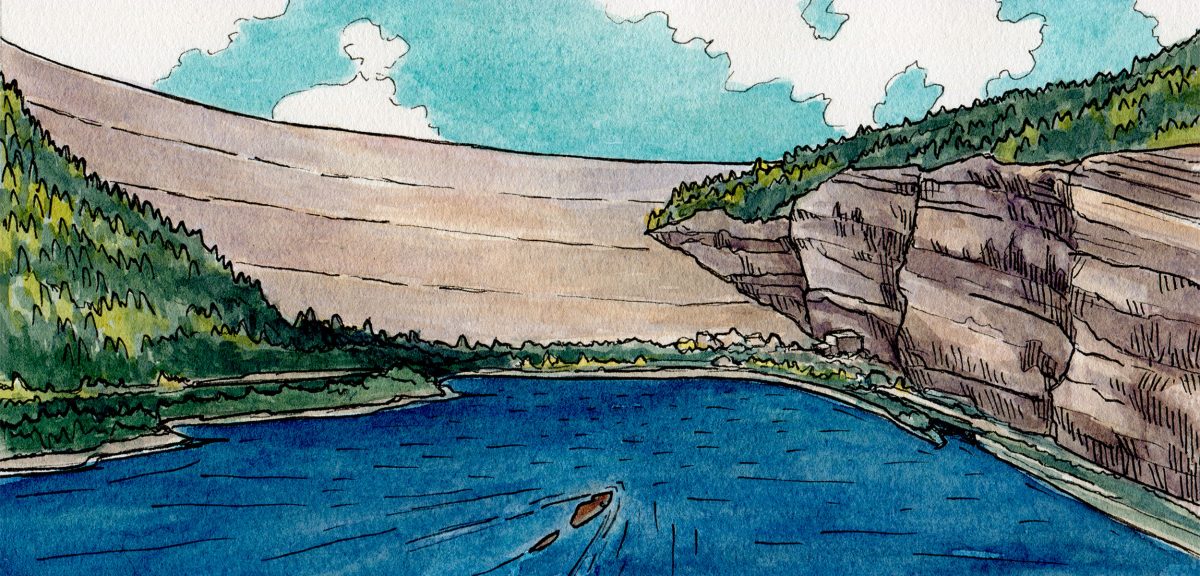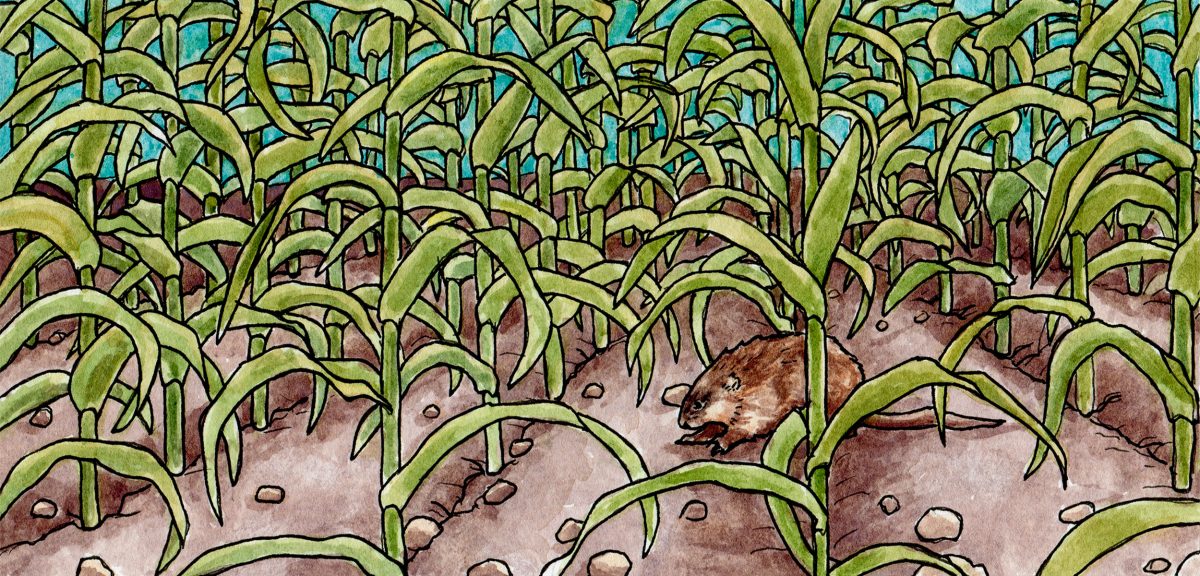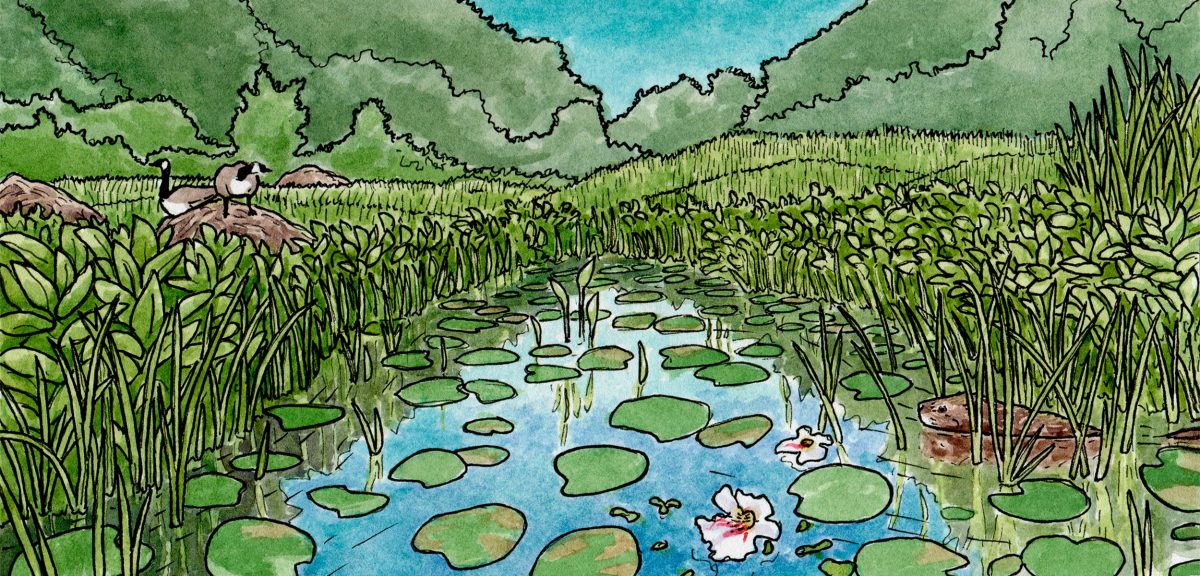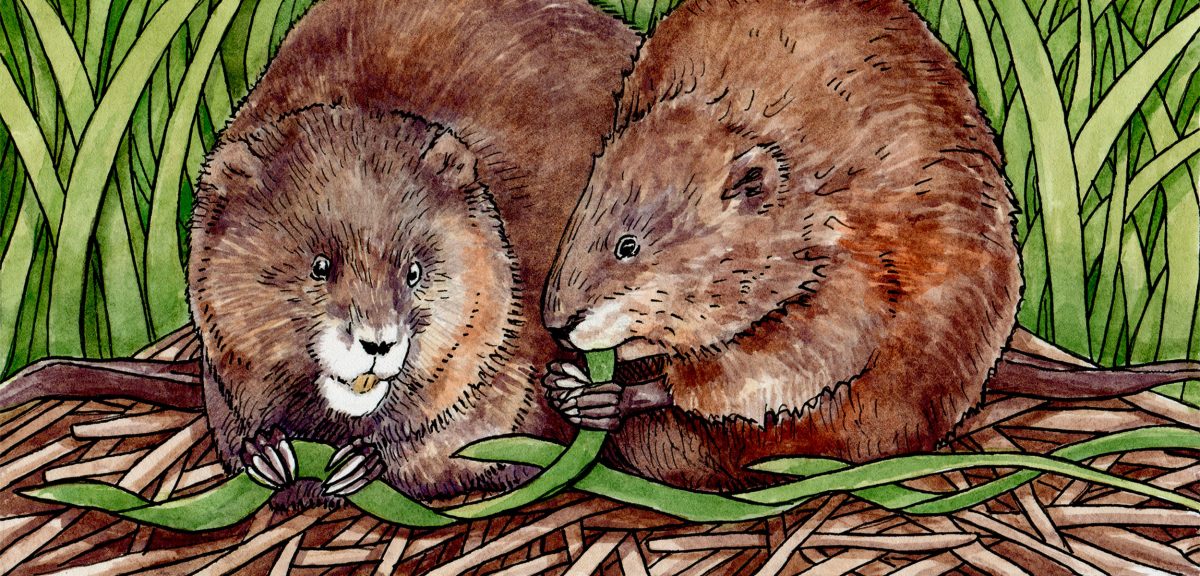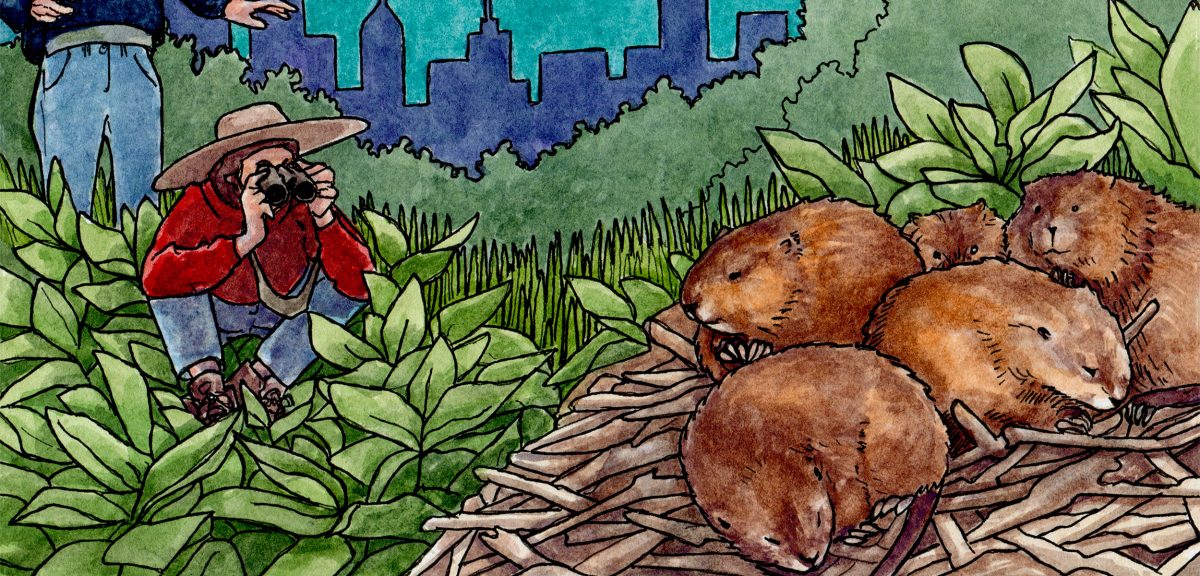The Waning Reign of the Wetland Architect We Barely Know (Hint: Not a Beaver)
Little-appreciated, semiaquatic, and cute-as-hell, muskrats can survive almost anywhere. So where are they?
Article body copy
When I was a teenager, my parents bought a home near an old farm pond in Bangor, Maine. A family of muskrats lived there and would go about their business as I lazed on the dock; I didn’t pay them close attention, as they were hardly glamorous creatures, and in retrospect, I took them for granted. Nevertheless, I did appreciate their presence. On warm-season evenings, the football-sized rodents—they resemble enormous voles or small, long-tailed beavers—would chug back and forth, harvesting cattails and carrying fronds to their den to eat in privacy. The sight of a whiskered nose held just above the water, a small bow wave preceding it, never ceased to lift my spirits.
When I learned last summer that muskrats as a species are struggling, the news came as a sad surprise, though the decline has been decades in the making. In the 1990s and early 2000s, around the same time as I met my farm-pond neighbors, the number of muskrats caught for their fur by trappers in the eastern United States and Canada started to drop, in some places precipitously. Wildlife managers typically use trapping data to track muskrat populations, but since the popularity of trapping had also dwindled, that seemed a likelier explanation for the downward trend than an actual population decline: after all, muskrats are known for their resilience.
They are prolific breeders, raising a dozen or more young per year in times of plenty, as happy and quick to set up house along a drainage ditch as in a wetland sanctuary. Even as other so-called furbearers were trapped to near-oblivion in the 19th and early 20th centuries, muskrats flourished, and they persisted through the thoughtless times before the adoption of federal clean water laws and the advent of environmental agencies in the United States and Canada. They’re the sort of species for whom the International Union for Conservation of Nature’s formal designation of “least concern” has seemed quite appropriate. Impervious would be another term.
Yet, reports of declines continued to gather from throughout their native range, which runs from the Arctic Circle to the US–Mexico border. In 2017, biologists Adam Ahlers of Kansas State University and Edward Heske at the University of Illinois Urbana-Champaign published the most comprehensive analysis to date, confirming that the patterns did not seem to be a function of trapping statistics. Something else was going on—and whatever it was, it was big. Since the early 1970s, muskrat populations appeared to have fallen by at least one-half in 34 US states. In a handful of states, the collapse was near-total, coming in between 90 and 99 percent.
Muskrats remain fairly common overall—no official population count exists, but it’s safe to ballpark within the millions throughout their range—and in some places, they still thrive, with as many lodges per wetland hectare as there are homes in a leafy suburban subdivision; researchers don’t fear their extinction, but the overall trend is deeply troubling. It is also mysterious. Many possible causes exist, from climate change to habitat fragmentation to vegetation shifts to disease, but “no one has really proposed a reason that seems like the most likely one,” says John Crockett, a wildlife ecologist and PhD candidate at the University of Rhode Island, where he is monitoring the Ocean State’s muskrats. “It’s just a muddle of different possible culprits.”
Crockett is among the few scientists and wildlife managers to study the phenomenon; outside that small circle, few people are even aware that muskrats are in trouble. The only media attention comes from regional outlets and university press releases. It’s a muted public response, considering the scale of loss—yet it’s also unsurprising, considering how little-appreciated muskrats are.
The animals are often mistaken for beavers, another semiaquatic rodent, albeit one whose adults weigh as much as a six-to-eight-year-old child; muskrats tip the scales at a couple kilograms. That lack of appreciation extends to the ecological roles performed by muskrats. Though their influences are subtle when compared with the wetland engineering of beavers, muskrats are still important habitat makers and nutrient movers. They help the world come to life, even if we don’t readily notice them doing so; their diminishment would reverberate far beyond them. It is also foreboding. What does it portend, and what does it say about how humans have transformed the world, when in so many places such a common, hardy animal can no longer thrive?
When Crockett and I first talk, in the spring of 2023, I confess to having only recently learned about the muskrat declines. “I had no idea either until I started this project,” Crockett replies. “They were always a species that I had classified in my mind as, They’re everywhere. They’re probably doing just fine.”
On a warm late-June morning, he meets me at a dam on the Blackstone River in Cumberland, Rhode Island, a few dozen kilometers inland from Narragansett Bay and near two of his study sites. Rhode Island’s muskrat populations are estimated to be roughly 15 percent of what they were several decades ago, but precise information about how many animals there are and where they live is lacking. Crockett has spent three field seasons surveying aquatic areas—marshes, bogs, swamps, lazy rivers, streams, ponds, brackish estuaries, anywhere a semiaquatic rodent might live—in order to compile a record of muskrats across the state.
“Ideally I’ll learn something about their distribution that tells us something useful for conserving them,” he says. We slip our kayaks off a launch and paddle slowly upriver, with Crockett drifting beneath the overhanging vegetation and looking for chewed shoots, muddy pullouts, or anything else that could signal a muskrat’s presence.
Among the questions researchers have is whether muskrats are impacted by Phragmites australis, a wetland-loving perennial grass native to Eurasia that has proliferated across North America, growing in dense stands that crowd out native vegetation and in particular cattails, a staple food for muskrats. Laurence Smith, an environmental scientist at Rhode Island’s Brown University who is also studying the state’s muskrat declines, has found compelling evidence that the rodents rarely eat phragmites and tend to avoid areas dominated by it. Yet, Crockett has also visited many ideal-looking sites where cattails grow in profusion but no muskrats can be found—so even if phragmites is a culprit, it only explains part of what’s happening.
This sort of murkiness characterizes every hypothesized explanation for the declines. Consider disease: in an age of apocalyptic bat and amphibian collapses caused by new fungal infections, and also avian influenza–induced bird die-offs, researchers have inevitably looked for pathogens that afflict muskrats. Of these, there are scores. No evidence suggests that any have caused significant population-scale problems, but knowing that with certainty would require the sort of long-term, landscape-scale monitoring programs that simply don’t exist for muskrats. Unless they die in a trap, their bodies go unfound.
If the impacts of disease are indirect or sublethal, tipping survival’s scales but only slightly, that would be harder still to detect. The effects of pollutants are similarly unclear. “Muskrats pick up a lot of things that empty into our river systems: contaminants, herbicides, pesticides, things like that,” says Laken Ganoe, another University of Rhode Island wildlife ecologist. “A lot of those things we don’t have well documented. We don’t know how they specifically affect the health of the animals.”
When Ganoe reviewed the scientific literature on pathogens and pollutants that affect muskrat health, compiling 131 articles published in the past century, she found only two that examined agricultural chemicals. Neither found clear signs of harm, but they were fairly small studies and together looked at just eight substances—a keyhole glimpse of the chemical cocktails commonly found where muskrat habitats receive runoff from agriculture or residential landscaping. Those “could be impacting muskrats in a lot of different ways,” says Crockett, but the picture is complicated by how muskrats frequently survive in heavily polluted waters yet may be scarce in places that are clean.
Another possibility is that muskrat habitats are changing in fundamental ways. Not only have many wetlands been lost to or degraded by human activity, but those that remain may be isolated, making it difficult for muskrats to travel between them and establish new homes. The importance of dispersal, as such movements are technically known, is neatly illustrated by research from northern Alberta’s vast Peace-Athabasca Delta, where the density of muskrat houses—the rodents often build mud-and-grass huts, counts of which are used as population proxies—has plummeted by 90 percent since the early 1970s.
The collapse coincided with the 1968 completion of British Columbia’s 185-meter-high WAC Bennett Dam, which choked the Peace River’s headwaters and transformed the delta’s hydrology. Previously, the floodplain was inundated regularly. Nowadays, it is subjected to long dry spells during which many waterbodies vanish altogether or become so shallow that in winter they freeze solid, preventing muskrats from feeding on underwater vegetation. (In addition to cattails, muskrats eat a wide range of aquatic plants, as well as crustaceans, frogs, and other small animals.) Warmer temperatures and reduced snowfall have compounded the desiccation. When scientists analyzed several decades of muskrat population surveys and satellite measurements of open water in the delta, they found a tight correlation between wetland loss and muskrat declines.
Researchers also found that hydrological changes did more than reduce the availability of habitat. They altered the dynamics of life in the delta. Muskrats there could be understood not as a single population but as a network of subpopulations who, in isolation, are prone to extirpation during dry periods and as vegetation shifts. Historically, those subpopulations were replenished by new muskrats arriving from elsewhere in the delta via routes created by flooding; but as the floodplain shriveled, so did the network. The now-isolated subpopulations would vanish, one by one, without being renewed—something that might be happening in the wider world, wrote the researchers, not just in the Peace-Athabasca Delta.
Adam Ahlers, coauthor of that landmark 2017 study of muskrat declines, agrees. “If you ask for my most educated opinion of why populations have declined, it’s the loss and degradation of wetlands, and the isolation of wetlands,” says Ahlers. “To have a functioning metapopulation, you have to have connectivity.”
He describes circumstances in Illinois, where much of his research is conducted: In precolonial times, an animal could walk 250 meters in any direction and have a 50 percent chance of entering a wetland. Today, they walk across roads and through endless farm fields; sometimes they survive in irrigation or drainage channels, but those are prone to extremes, with muskrats alternately flooded out or left high and dry, vulnerable to predators and deprived of food.
Yet, even as Ahlers thinks these changes are most to blame, he doesn’t think they explain all the declines. It is possible that all the above-mentioned factors—and others not discussed, such as shifts in predator populations or the collapse of freshwater mussels muskrats may depend upon in lean times—could be implicated, with one or more afflicting them in different places. In this case, the declines could be understood not as the consequence of any one issue but the result of a world made inhospitable by humans.
Crockett and I make our way slowly upriver to an early-summer soundtrack of red-winged blackbirds, robins, and song sparrows. We see no muskrats, but after about half an hour, he finds a sign: an old snag protruding from the water makes a perfect place for a muskrat to sit, and upon closer inspection, a single scat rests upon it. Crockett meticulously writes this down in his notebook; note by note, a picture of Rhode Island’s muskrats will eventually emerge.
A long-legged spider perches beside the scat, perhaps attracted by insects who themselves are attracted to its concentration of nutrients. By such increments ecosystems cohere and flourish, and the tableau makes for a small demonstration of a role played by muskrats: they cycle and transport nutrients. That’s not so important on a river like the Blackstone, says Crockett, where nutrients are moved by large-bodied fish—not to mention sewage treatment plants, of which there is one upriver in Woonsocket and another at the Blackstone’s headwaters in Worcester, Massachusetts—but in a wetland where waters are still, he says, muskrats are much more significant.
In a little while, we enter just such a place, a long, shallow basin adjacent to the river’s main stem where the water is still and profuse with emergent vegetation: pickerelweed, arrowhead, reeds, and pond lilies, rimmed by stands of cattails. “In some of these wetlands, what happens within that one little pocket is all that’s ever going to happen,” says Crockett. “If there is or isn’t an herbivore will make a big difference.”
In these places, grazing by muskrats takes up nutrients locked in plants and spreads them around. And not just from plants: when muskrats eat mussels, which they gather and eat in favored dining spots, day after day, they create mounds of discarded shells that are fountains of calcium on the landscape. Their grazing also helps prevent vegetation from becoming so dense that over time it builds up, forms soil, and turns the wetland into land. The scientific name for what muskrats help produce is hemi-marsh: about half vegetation and half open water, a configuration that has coevolved with a menagerie of wetland species.
Ducks use that open water. Light penetrates it, nourishing plankton and in turn small fish and aquatic invertebrates and a different set of subaquatic vegetation, not unlike sunbeams in a forest clearing. Laurence Smith describes how, when muskrats build houses in cattail marshes, they clear a circle some five or six meters across, and then when they depart, the vegetation regrows. The result is a patchwork of variation across time as well as space. “It’s a form of disturbance,” says Smith. “Disturbance is good. Disturbance provides diversity of ages and decomposition on the landscape.”
In his review of muskrat ecosystem impacts, Ahlers describes how these disturbances produce dramatic increases in plant species richness. One study suggested that muskrats were primarily responsible for an increase of more than 70 percent in the variety of plants found in the disturbed areas of a cattail marsh; by grazing on abundant plants that would otherwise become dominant, muskrats also create space for rare plants to grow. Meanwhile, their houses—a meter or more from the water and up to two meters wide, lasting for a year or two before gradually degrading—become habitat features themselves. “Birds are probably the most conspicuous beneficiaries of the muskrat’s influence on wetlands,” writes Ahlers, including the ducks, terns, grebes, and other wetland avians who use muskrat houses as nesting sites. Turtles, water snakes, and frogs also dwell in them, and even skunks and shrews—more than 60 vertebrate species altogether, by one count.
These animals also avail themselves of the reed feeding platforms that muskrats construct. So do beetles and other invertebrates, and in turn their predators benefit. As the platforms decompose, they even increase local microbial diversity. And where muskrats dig dens in banks along the water’s edge rather than build houses, their burrowing aerates riparian soils, and those subterranean chambers become habitat for reptiles and amphibians. “When you remove them,” says Smith of muskrats, “the ecology of the wetland changes.”
Morgan Lucot, a biologist with Rhode Island’s Department of Environmental Management who is collaborating with Crockett and Smith, says that muskrats complement the better-known habitat transformations of the beavers with whom they share wetlands. The latter create wetlands; muskrats maintain them. “Beaver do it on a really large scale. Muskrat do it on a very small scale,” she says. “To have a really healthy ecosystem, you need large-scale and fine-scale diversity.” It is fitting that muskrats figure prominently in many Indigenous ontologies. The best known of these is an Anishinaabe story, popularized by Robin Wall Kimmerer in Braiding Sweetgrass, of how Muskrat dove to the bottom of a deluged Earth, recovering the mud from which the terrestrial world would eventually be formed.
“A loss of muskrats comes with significant costs, many of which we might already be experiencing,” wrote biologists with Ontario’s ministry of natural resources after documenting muskrat house count declines of more than 90 percent in Point Pelee National Park. “A scarcity of muskrats should be considered a red flag for the state of biodiversity in our wetlands.”
As Crockett and I paddle through the channel, a large something surfaces and then dives beside my prow, leaving an impression of slow power. A snapping turtle, most likely. They are regular consumers of muskrats, as are minks, raccoons, owls, and a host of other creatures. And then, as we pass the channel’s entrance, there, in the shallows at the base of an arrowroot stand, the morning sunshine lighting the mélange of cinnamon, auburn, and umber that makes up their coat, nibbling contentedly on a frond, is a muskrat.
A convention of nature writing, so prevalent as to be taken for granted, is to present animals as emblematic of their species. One may easily talk about ecological roles or life histories—but not so easily about individuals, about beings with a first-person experience of their own lives. Who was that muskrat? Passing by, catching a glimpse, I could not know.
Biologists, who know muskrats mostly by watching them from a distance, don’t necessarily offer this perspective, nor do wildlife managers or trappers. For that, we may turn to someone like Jennifer Marchigiani, who in 2002 opened Misfits Rehab in Auburn, Maine. Since then, she has cared for thousands of orphaned, sick, and injured wild animals. Raccoons and squirrels and possums are her most common patients, and turtles during their migration—road-crossing—season, but once or twice a year, someone will bring in a muskrat.
As a rule, says Marchigiani, they are quite shy and skittish. Even as juveniles, an age when raccoons and squirrels readily habituate to human caretakers, muskrats keep to themselves. When she or her helpers are in the room, muskrats are wary: not fearful but watchful, often retreating into their hideouts, as befits creatures who so readily become meals. When she leaves the room, though, it’s a different story.
On the video cameras she sets up to watch her patients from afar, Marchigiani can see what muskrats do when nobody is watching. “They are very playful,” she says, much like ferrets in that regard, hopping and pouncing and wrestling with the stuffed animals their caretakers give them. “They are hilarious animals to watch.”
Marchigiani has had few opportunities to observe them with one another—most of her muskrats come in alone—but once she cared for two very young muskrats. They were found beside a road, likely orphaned siblings, and spent much of their time cuddling, grooming, and talking in high-pitched voices. One had a broken leg and stayed in their hideout during the weeks it took to heal. At feeding times, his sister would emerge, fetch him a piece of apple or some other delectable treat, and then go back for her own serving before joining him.
“It was really fascinating. That’s not so typical for most wildlife,” she says. “It’s usually survival of the fittest. Even squirrels, they fight and wrestle and try to push the other one away from the feed.” Such observations hint at the social tenor of muskrats’ lives in the wild, where one study led by Laken Ganoe found that, on average, each muskrat shared nine lodges with various other muskrats, with most of their home territories overlapping. William Long, a popular naturalist in the early 20th century, wrote of pressing an ear to a lodge in springtime, when “their squeaky little voices and the low mumble of one voice sound like an echo of the general heyday outside.”
Such observations also make more poignant the matter of trapping, which remains the most common of the relationships that humans have with muskrats. In Adam Ahlers’s 2017 study of muskrat declines, he cites data from the Association of Fish and Wildlife Agencies, which reported that over 132 million muskrats had been trapped in the United States between 1970 and 2012. Those figures covered only 37 states for which adequate data existed, so the actual number is higher. In most places, there are no legal limits on how many muskrats someone may kill.
Trapping rates have dropped in recent years, of course, and there’s broad agreement among scientists who’ve studied the muskrat declines that trapping is not a factor. It should also be noted that much of the data, and much of the concern over their fate as a species, comes from people who trap and researchers who work with them.
Still, there is an ethical dimension that can’t be elided simply by saying populations matter, not individuals. The full conversation is one for another day, but it’s fair to say this: after all that muskrats have done for the world and for us, and all that we have taken from them, we owe them.
After a minute or so, the muskrat departs, and the encounter is recorded. Crockett and I paddle back to the launch. This is one of his last field trips. No explanation for muskrat declines has yet emerged from his data, but the analysis is not complete. Perhaps the answer will be found by someone who builds on these observations. “I would love to have done this 40 years ago also, and have sort of a before-and-after,” he says. “But we can at least get a before for somebody else.”
When Crockett is finished, he’ll have compiled the first state-wide survey of muskrats in Rhode Island. Part of the reason it took so long for their declines to be detected, and why it’s so hard to make sense of them, is that baseline data is so incomplete. Trapping records are useful but far from statistically ideal. Laurence Smith is developing tools that detect the presence of muskrats from DNA traces in water samples; that would be even simpler and possibly more reliable than what Crockett is doing, and could be conducted relatively inexpensively on a large scale. And perhaps the people collecting that data would be not only wildlife managers, trappers, and scientists, but nature- and animal-loving citizens as well, mobilized to keep an eye on the muskrats in their locale.
There is something that gives Crockett hope: muskrats do just fine around us.
One pattern to emerge from his data and elsewhere is that muskrats have fared just as well in urban as in wilder places. When Smith tested his muskrat DNA detection system, the best locations he found were in cattail-rich wetlands in the city of Providence, one of them downstream from a Superfund site. The Blackstone River was, until not long ago, intensely polluted; an original artery of the Industrial Revolution, its modern contours have been shaped by several centuries of intense human activity. Behind the channel where we saw our muskrat was an old sewage treatment plant. The morning’s songbird chorus made itself heard over the din of a nearby quarry and traffic passing overhead on a bridge of Interstate 99, the Woonsocket Industrial Highway.
Behind the lush riparian vegetation was a bicycle path, residential neighborhoods, a Walmart. When Marchigiani released those affectionate siblings, she did so into a suburban wetland behind a shopping plaza: their home. “It’s not like a grizzly bear,” says Crockett. “They don’t need thousands of square miles. They just need a pond or a hundred-meter stretch of river.” There is still space in this world for muskrats, and they can still bring our world to life.

